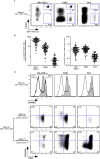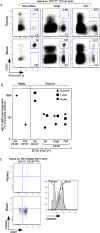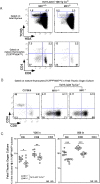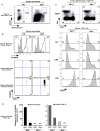Stepwise development of MAIT cells in mouse and human
- PMID: 19278296
- PMCID: PMC2653554
- DOI: 10.1371/journal.pbio.1000054
Stepwise development of MAIT cells in mouse and human
Abstract
Mucosal-associated invariant T (MAIT) cells display two evolutionarily conserved features: an invariant T cell receptor (TCR)alpha (iTCRalpha) chain and restriction by the nonpolymorphic class Ib major histocompatibility complex (MHC) molecule, MHC-related molecule 1 (MR1). MR1 expression on thymus epithelial cells is not necessary for MAIT cell development but their accumulation in the gut requires MR1 expressing B cells and commensal flora. MAIT cell development is poorly known, as these cells have not been found in the thymus so far. Herein, complementary human and mouse experiments using an anti-humanValpha7.2 antibody and MAIT cell-specific iTCRalpha and TCRbeta transgenic mice in different genetic backgrounds show that MAIT cell development is a stepwise process, with an intra-thymic selection followed by peripheral expansion. Mouse MAIT cells are selected in an MR1-dependent manner both in fetal thymic organ culture and in double iTCRalpha and TCRbeta transgenic RAG knockout mice. In the latter mice, MAIT cells do not expand in the periphery unless B cells are added back by adoptive transfer, showing that B cells are not required for the initial thymic selection step but for the peripheral accumulation. In humans, contrary to natural killer T (NKT) cells, MAIT cells display a naïve phenotype in the thymus as well as in cord blood where they are in low numbers. After birth, MAIT cells acquire a memory phenotype and expand dramatically, up to 1%-4% of blood T cells. Finally, in contrast with NKT cells, human MAIT cell development is independent of the molecular adaptor SAP. Interestingly, mouse MAIT cells display a naïve phenotype and do not express the ZBTB16 transcription factor, which, in contrast, is expressed by NKT cells and the memory human MAIT cells found in the periphery after birth. In conclusion, MAIT cells are selected by MR1 in the thymus on a non-B non-T hematopoietic cell, and acquire a memory phenotype and expand in the periphery in a process dependent both upon B cells and the bacterial flora. Thus, their development follows a unique pattern at the crossroad of NKT and gammadelta T cells.
Conflict of interest statement
Competing interests. OL laboratory has received funding from Innate-Pharma, which co-owns the filled patent for the 3C10 antibody. EM has received salary through this funding.
Figures






References
-
- Hayday AC. [gamma][delta] cells: a right time and a right place for a conserved third way of protection. Annu Rev Immunol. 2000;18:975–1026. - PubMed
-
- Bendelac A, Bonneville M, Kearney JF. Autoreactivity by design: innate B and T lymphocytes. Nat Rev Immunol. 2001;1:177–186. - PubMed
-
- Bendelac A, Savage PB, Teyton L. The biology of NKT cells. Annu Rev Immunol. 2007;25:297–336. - PubMed
-
- Treiner E, Lantz O. CD1d- and MR1-restricted invariant T cells: of mice and men. Curr Opin Immunol. 2006;18:519–526. - PubMed
-
- Lambolez F, Arcangeli ML, Joret AM, Pasqualetto V, Cordier C, et al. The thymus exports long-lived fully committed T cell precursors that can colonize primary lymphoid organs. Nat Immunol. 2006;7:76–82. - PubMed
Publication types
MeSH terms
Substances
LinkOut - more resources
Full Text Sources
Other Literature Sources
Molecular Biology Databases
Research Materials
Miscellaneous

